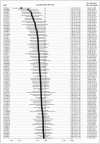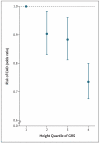Genetically determined height and coronary artery disease
- PMID: 25853659
- PMCID: PMC4648271
- DOI: 10.1056/NEJMoa1404881
Genetically determined height and coronary artery disease
Abstract
Background: The nature and underlying mechanisms of an inverse association between adult height and the risk of coronary artery disease (CAD) are unclear.
Methods: We used a genetic approach to investigate the association between height and CAD, using 180 height-associated genetic variants. We tested the association between a change in genetically determined height of 1 SD (6.5 cm) with the risk of CAD in 65,066 cases and 128,383 controls. Using individual-level genotype data from 18,249 persons, we also examined the risk of CAD associated with the presence of various numbers of height-associated alleles. To identify putative mechanisms, we analyzed whether genetically determined height was associated with known cardiovascular risk factors and performed a pathway analysis of the height-associated genes.
Results: We observed a relative increase of 13.5% (95% confidence interval [CI], 5.4 to 22.1; P<0.001) in the risk of CAD per 1-SD decrease in genetically determined height. There was a graded relationship between the presence of an increased number of height-raising variants and a reduced risk of CAD (odds ratio for height quartile 4 versus quartile 1, 0.74; 95% CI, 0.68 to 0.84; P<0.001). Of the 12 risk factors that we studied, we observed significant associations only with levels of low-density lipoprotein cholesterol and triglycerides (accounting for approximately 30% of the association). We identified several overlapping pathways involving genes associated with both development and atherosclerosis.
Conclusions: There is a primary association between a genetically determined shorter height and an increased risk of CAD, a link that is partly explained by the association between shorter height and an adverse lipid profile. Shared biologic processes that determine achieved height and the development of atherosclerosis may explain some of the association. (Funded by the British Heart Foundation and others.).
Figures




Comment in
-
Shorter adult height is linked to raised risk of coronary artery disease, study shows.BMJ. 2015 Apr 9;350:h1875. doi: 10.1136/bmj.h1875. BMJ. 2015. PMID: 25857438 No abstract available.
References
-
- Paajanen TA, Oksala NKJ, Kuukasjärvi P, Karhunen PJ. Short stature is associated with coronary heart disease: a systematic review of the literature and a meta-analysis. Eur Heart J. 2010;31:1802–9. - PubMed
Publication types
MeSH terms
Substances
Grants and funding
LinkOut - more resources
Full Text Sources
Medical
Miscellaneous
